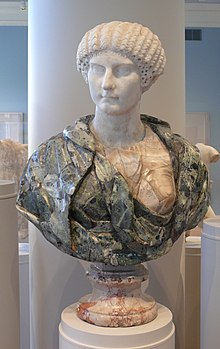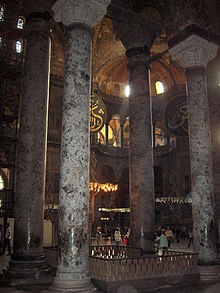
Marble is a metamorphic rock consisting of carbonate minerals (most commonly calcite (CaCO3) or dolomite (CaMg(CO3)2)) that have recrystallized under the influence of heat and pressure. It has a crystalline texture, and is typically not foliated (layered), although there are exceptions.

Hagia Sophia, officially the Hagia Sophia Grand Mosque, is a converted former church and mosque and a major cultural and historical site in Istanbul, Turkey. The last of three church buildings to be successively erected on the site by the Eastern Roman Empire, it was completed in 537 AD. The site was an Eastern Orthodox church from 360 AD to 1204, when it was converted to a Catholic church following the Fourth Crusade. It was reclaimed in 1261 and remained Eastern Orthodox until the Ottoman conquest of Constantinople in 1453. It served as a mosque until 1935, when it became a museum. In 2020, the site once again became a mosque and by 2024 partially closed off for non Muslim visitors.

Porphyry is any of various granites or igneous rocks with coarse-grained crystals such as feldspar or quartz dispersed in a fine-grained silicate-rich, generally aphanitic matrix or groundmass. In its non-geologic, traditional use, the term porphyry usually refers to the purple-red form of this stone, valued for its appearance, but other colours of decorative porphyry are also used such as "green", "black" and "grey".

Byzantine architecture is the architecture of the Byzantine Empire, or Eastern Roman Empire, usually dated from 330 AD, when Constantine the Great established a new Roman capital in Byzantium, which became Constantinople, until the fall of the Byzantine Empire in 1453. There was initially no hard line between the Byzantine and Roman Empires, and early Byzantine architecture is stylistically and structurally indistinguishable from late Roman architecture. The style continued to be based on arches, vaults and domes, often on a large scale. Wall mosaics with gold backgrounds became standard for the grandest buildings, with frescos a cheaper alternative.

The Hippodrome of Constantinople, was a circus that was the sporting and social centre of Constantinople, capital of the Byzantine Empire. Today it is a square in Istanbul, Turkey, known as Sultanahmet Square.

Serpentine subgroup are greenish, brownish, or spotted minerals commonly found in serpentinite. They are used as a source of magnesium and asbestos, and as decorative stone. The name comes from the greenish color and smooth or scaly appearance from the Latin serpentinus, meaning "serpent rock".

Scagliola is a type of fine plaster used in architecture and sculpture. The same term identifies the technique for producing columns, sculptures, and other architectural elements that resemble inlays in marble. The scagliola technique came into fashion in 17th-century Tuscany as an effective substitute for costly marble inlays, the pietra dura works created for the Medici family in Florence. The use of scagliola declined in the 20th century.

A templon is a feature of Byzantine churches consisting of a barrier separating the nave from the sanctuary near the altar.

Serpentinite is a rock composed predominantly of one or more serpentine group minerals formed by near to complete serpentinization of mafic to ultramafic rocks. Its name originated from the similarity of the texture of the rock to that of the skin of a snake. Serpentinite has been called serpentine or serpentine rock, particularly in older geological texts and in wider cultural settings.
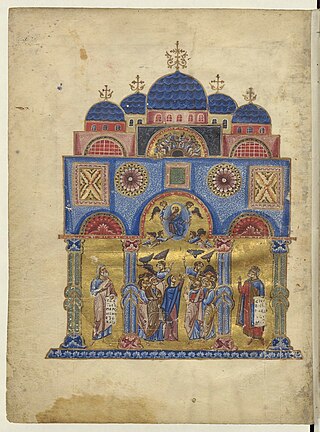
The Church of the Holy Apostles, also known as the Imperial Polyandrion, was a Byzantine Eastern Orthodox church in Constantinople, capital of the Eastern Roman Empire. The first structure dated to the 4th century, though future emperors would add to and improve upon it. It was second in size and importance only to the Hagia Sophia among the great churches of the capital.

The conversion of non-Islamic places of worship into mosques occurred during the life of Muhammad and continued during subsequent Islamic conquests and under historical Muslim rule. Hindu temples, Jain Temples, Christian churches, synagogues, and Zoroastrian fire temples have been converted into mosques.
Cardiff is an unincorporated community in Harford County, Maryland, United States. The zip code for the area is 21160. The community name is taken from the Capital city of Wales.
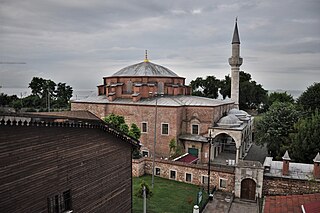
The Little Hagia Sophia mosque, formerly the Church of Saints Sergius and Bacchus, is a former Greek Orthodox church dedicated to Saints Sergius and Bacchus in Constantinople, built between 532 and 536, and converted into a mosque during the Ottoman Empire.

St. Patrick's Catholic Church is a Catholic church in San Francisco, California, founded in 1851. It is located at 756 Mission Street, between 3rd and 4th streets, across the street from Yerba Buena Gardens in the heart of the South of Market district.
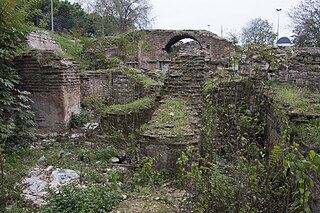
The Church of St. Polyeuctus was an ancient Byzantine church in Constantinople built by the noblewoman Anicia Juliana and dedicated to Saint Polyeuctus. Intended as an assertion of Juliana's own imperial lineage, it was a lavishly decorated building, and the largest church of the city before the construction of the Hagia Sophia. It introduced the large-scale use of Sassanid Persian decorative elements, and may have inaugurated the new architectural type of domed basilica, perfected in the later Hagia Sophia.

Pavonazzo marble, also known as Pavonazzetto, Docimaean marble or Synnadic marble, is a whitish marble originally from Docimium, or modern İscehisar, Turkey.

The Church of the Acheiropoietos is a 5th-century Byzantine church in the northern Greek city of Thessaloniki, Central Macedonia. It is located in the city's centre, at Agias Sofias street opposite Makedonomachon square. Because of its outstanding early Byzantine architecture, the church was inscribed on the UNESCO World Heritage List in 1988 along with other Paleochristian and Byzantine monuments of Thessaloniki.
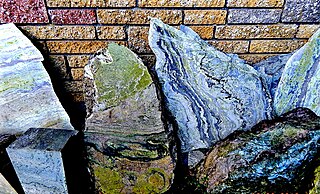
Connemara marble or "Irish green" is a rare variety of green marble from Connemara, Ireland. It is used as a decoration and building material. Its colour causes it to often be associated with the Irish identity, and for this reason it has been named the national gemstone of Ireland. It strongly resembles the verd antique, a green serpentinite breccia found in the Mediterranean. It is named after the region in which it is found. The marble was deposited as a limestone mud during the neoproterozoic.
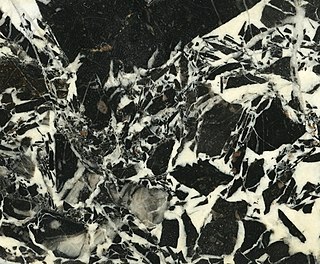
Grand antique marble, is a prestigious marble, composed of clasts of black limestone and white calcite, quarried near Aubert-Moulis in France. The fault breccia from which it is extracted was formed at the end of the Cretaceous period, following the corrugation that affected the Northern Pyrenean area about 65 million years ago.

